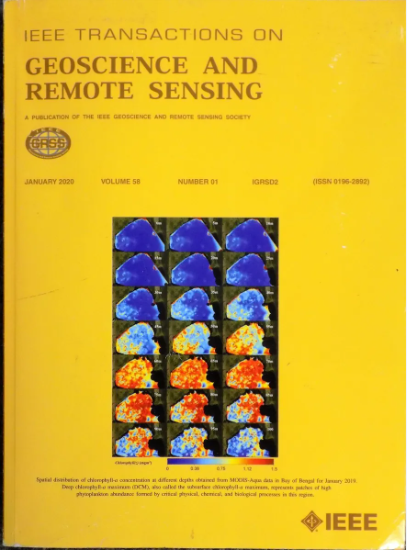NOAA-21 VIIRS 热发射波段早期在轨校准性能与改进
IF 7.5
1区 地球科学
Q1 ENGINEERING, ELECTRICAL & ELECTRONIC
IEEE Transactions on Geoscience and Remote Sensing
Pub Date : 2024-09-11
DOI:10.1109/TGRS.2024.3458869
引用次数: 0
摘要
美国国家海洋和大气管理局-21(NOAA-21)卫星上的可见红外成像辐射计套件(VIIRS)于 2022 年 11 月 10 日发射,此前,Suomi 国家极轨伙伴关系(S-NPP)和 NOAA-20 卫星上的 VIIRS 已成功运行。本文介绍了 NOAA-21 VIIRS 热辐射波段(TEBs)的早期在轨校准性能,包括仪器温度遥测趋势、TEB 增益、噪声和校准稳定性以及 NOAA 运行传感器数据记录(SDR)中的偏差。与 S-NPP 和 NOAA-20 不同,NOAA-21 VIIRS TEB 在其早期任务中经历了明显的在轨增益变化,这是由探测器响应性退化、任务中期排气(MMOG)和冷焦平面组件设定点温度切换造成的。NOAA-21 VIIRS TEB SDR 的校准稳定性和偏差是通过与同地交叉轨道红外探测器(CrIS)观测光谱和间隙填充光谱进行相互比较来分析的。除了已知的 VIIRS 或 CrIS 仪器设置或校准更新造成的微小变化外,NOAA-21 TEB SDR 一直很稳定。VIIRS 长波红外波段与 CrIS 的吻合度在 0.1K 以内;M13 与 CrIS 的吻合度约为 0.13K。从航天器俯仰机动数据中得出的校准参数首次应用于业务处理,更新后有效减少了长波红外扫描角度和场景温度相关偏差。与 S-NPP 和 NOAA-20 VIIRS 类似,NOAA-21 VIIRS TEB 在黑体升温/降温(WUCD)测试期间也表现出校准异常。NOAA-21 WUCD 偏差校正系数已经开发并部署到支持海面温度(SST)应用的业务中。本文章由计算机程序翻译,如有差异,请以英文原文为准。
NOAA-21 VIIRS Thermal Emissive Bands Early On-Orbit Calibration Performance and Improvements
The Visible Infrared Imaging Radiometer Suite (VIIRS) onboard the National Oceanic and Atmospheric Administration-21 (NOAA-21) satellite was launch on November 10, 2022, following the successful operations of the VIIRS onboard the Suomi National Polar-orbiting Partnership (S-NPP) and NOAA-20 satellites. This article presents NOAA-21 VIIRS thermal emissive bands (TEBs) early on-orbit calibration performance, including instrument temperature telemetry trending, TEB gains, noise, and calibration stability as well as biases in the NOAA operational sensor data records (SDR). Different from S-NPP and NOAA-20, NOAA-21 VIIRS TEBs have experienced distinct on-orbit gain changes during its early mission, caused by detector responsivity degradations, mid-mission outgassing (MMOG), and the cold focal plane assembly setpoint temperature switch. The calibration stability and biases of NOAA-21 VIIRS TEB SDRs were analyzed by intercomparing with co-located Cross-Track Infrared Sounder (CrIS) observed and gap-filled spectra. NOAA-21 TEB SDRs have been stable, except for small changes caused by known VIIRS or CrIS instrument setting or calibration updates. VIIRS longwave infrared (LWIR) bands agree with CrIS within 0.1 K; M13 agrees with CrIS ~0.13 K. Calibration parameters derived from the spacecraft pitch maneuver data were applied for the first time in the operational processing, and LWIR scan angle and scene temperature-dependent biases were effectively reduced after that update. Similar to S-NPP and NOAA-20 VIIRS, NOAA-21 VIIRS TEBs also exhibit calibration anomalies during the blackbody warm-up/cool-down (WUCD) tests. NOAA-21 WUCD bias correction coefficients were developed and deployed to the operations for supporting sea surface temperature (SST) applications.
求助全文
通过发布文献求助,成功后即可免费获取论文全文。
去求助
来源期刊

IEEE Transactions on Geoscience and Remote Sensing
工程技术-地球化学与地球物理
CiteScore
11.50
自引率
28.00%
发文量
1912
审稿时长
4.0 months
期刊介绍:
IEEE Transactions on Geoscience and Remote Sensing (TGRS) is a monthly publication that focuses on the theory, concepts, and techniques of science and engineering as applied to sensing the land, oceans, atmosphere, and space; and the processing, interpretation, and dissemination of this information.
 求助内容:
求助内容: 应助结果提醒方式:
应助结果提醒方式:


